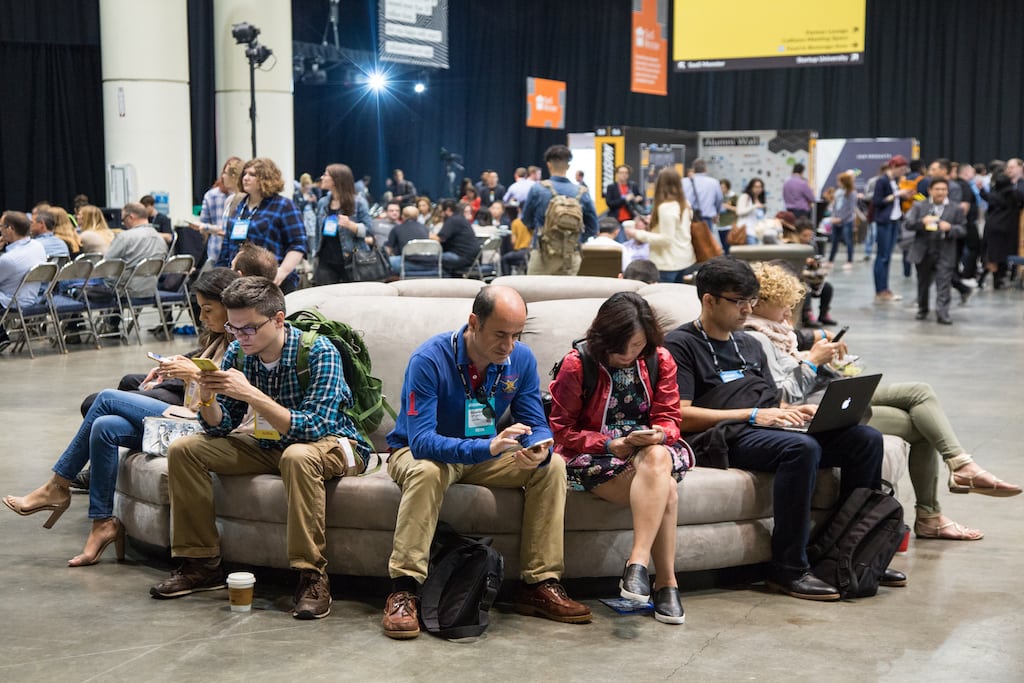Bridging the Digital Divide for Meetings and Events

Skift Take
What's the right balance between digital innovation and a focus on event experience or face-to-face interaction?
An integrated approach can pay dividends for both event planners and attendees, yet there's still debate on how to create the best experiences.
Brian Friedman, vice president of digital innovation at event technology company Etouches, thinks that empowering event planners with a variety of tools is only the beginning of a shift in overall event management.
"Connections are core at the event," said Friedman. "What does that mean? It means attendees can connect with exhibitors, attendees can connect with others, and attendees can connect with content. The more connections you have, the more social capital and marketing value you get from it."
Skift spoke to Friedman about the power of customization, the emergence of augmented reality, and the real limits of attendee personalization right now.
Skift: How do you look at the divide between offering individual solutions to meeting planners and the rise of platforms in the ecosystem?
Brian Friedman: We're focusing on having really intuitive and innovative platforms that have full functionality. So the idea is that you can come to Etouches, we're a one-stop shop that has really powerful solutions. There are other event companies out there where the more functionality you have, the more technical experience you need to have. And with ours, it's really easy for someone who's not technical to do more or customize.
The first focus over the last year was having our new user interface released. We worked with some really creative designers who worked with products like Foursquare and Twitter, and we implemented a smart contextual dashboard. Rather than just presenting data for event planners and marketers during the event, we want to present data to give an event marketer the ability to see what actions they need to take place before and after the event.
Skift: Does a focus on data and apps take away from the physical, interactive elements of an event?
Friedman: We look at why you have events in the first place: face-to-face experience. If it wasn't about connecting with people or having interactive contact with speakers presenting, then you could always have a webinar. Connections are core at the event. What does that mean? It means attendees can connect with exhibitors, attendees can connect with others, attendees can connect with content. And the more connections you have, the more social capital and marketing value you get from it.
How do we get the right attendees in the right room? How can we engage with those attendees so they interact with the right content, the right people, and how do we make sure that they can act in a way where they're building the brand culture?
Skift: I always think about the contrast between digital natives and older generations. How are your clients working on ways to appeal to attendees regardless of their technological inclinations? Events become boring for very different reasons to different kinds of people.
Friedman: We've seen a combination starting as a personalized experience digitally and then having that personalized experience carried throughout the event. That way you're really building an emotional connection with the brand and hopefully the attendees will come back.
Our goal, other than to help people have the best physical face-to-face immersive experiences, is to make sure that our [digital tools] don't take them away from the event. If it's not enhancing their experience, but takes them somewhere digitally, it's kind of defeating the purpose because it's competing with the event.
Similar to how Google does it. You have the ability to opt in. We say the more information they share, the better the recommendations, the better insights you'll receive. You can also opt out, where you're saying you know what, I only want the information, I don't want it curated or personalized to myself.
Skift: It seems like augmented reality could emerge to be a powerful way to enhance experiences for attendees. It uses technology to engage attendees in a physical space, instead of distracting them.
Friedman: Our goal is to establish meaningful connections with attendees, and the exhibitors and speakers at the event. So, we're looking at technology that can enhance that event experience. From the attendee perspective, augmented reality is definitely something that we're looking into heavily. It allows exhibitors to have more interaction, it's digital plus the physical layer. And for the attendee, it really opens up [interactive opportunities].
So it goes back to what you're saying, these events get boring over time, and that is ... you might've said, "Well, my goal is to be educated on the topic, or to meet more people with a similar interest," and that augmented reality experience can then guide you to achieve your goal.
Skift: What other forms of technology is your team working on?
Friedman: We're also looking heavily into artificial intelligence, we're doing some machine learning algorithms. There are still a lot of manual steps within the technology that could be automated. And similar to an airplane where you have autopilot, we want event marketers to have the ability to say, "You know what, I trust Etouches, you can take over, I like your recommendations."
The third thing that we're looking at, which we find interesting, is holograms... it's just this amazing combination of digital and physical.
We're also trying to think about how can we reinvent the entire event experience, where we create word of mouth and guerrilla marketing campaigns for these events.
Skift: Aren't holograms ridiculously expensive at this point? I'm not so sure they're really feasible for most events.
Friedman: That's a good point. For holograms it's definitely further off, I'd say, two to three years. For augmented reality, there are already augmented kits that are pretty sophisticated, so for images, it's definitely ready now. Augmented is definitely something within the next year that we'll come out with.
When it comes to artificial intelligence, it's getting more advanced, depending on how deep you want to go, whether you want the system to start learning by itself, or if you want the system to be trained by your data. So that's something that we actively have going on. We look at the new technology that's coming out, and we have small think tanks where we can try to build out prototypes. And then if it works, once again, since we have this new funding, we can say let's go all in and make it happen.
And for a lot of these new on-site experiences, where event planners come and say, "I want to make sure attendees are connecting more," or "I want to make sure our attendees are staying longer at speaker sessions," we believe that augmented reality can help out a lot there, and we tend to see that ... We don't say, "Hey, we made an augmented reality solution for you," we say that we have this new experience that will solve your problem and it's powered by augmented reality.




